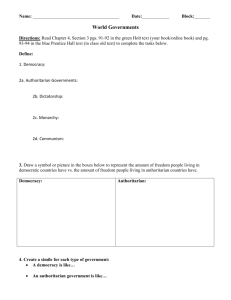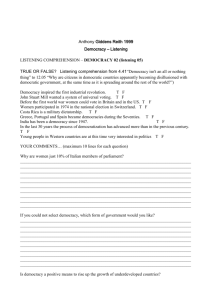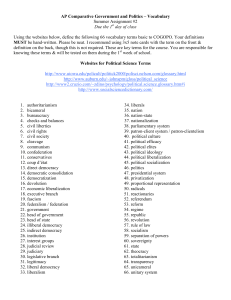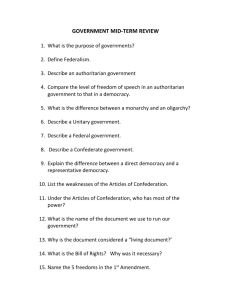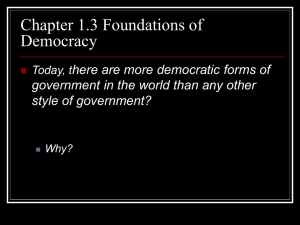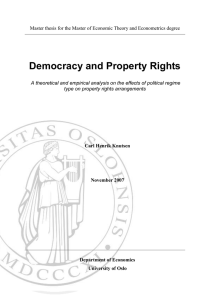Unit 1- Concepts in Comparative Government
advertisement
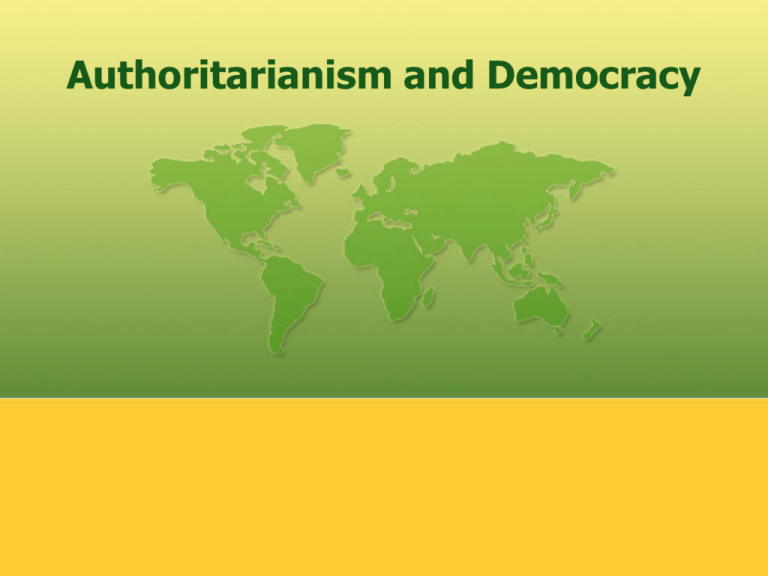
Authoritarianism and Democracy Authoritarianism and Totalitarianism (nondemocratic regimes) • • • Authoritarianism is a • Totalitarianism is a highly political regime where a centralized regime that small group of individuals possesses some form of strong exercises power over the ideology that seeks to state without being transform and absorb aspects of the state, society, and the constitutionally responsible economy. to the public. Authoritarian Regimes are • It seeks to use power to transform the total fabric of a built upon the restriction of nation, which distinguishes it individual freedom. from authoritarianism. They are, rarely, driven by • Totalitarianism shatters human ideology, but rather will, and destroys the ability of through the whims of those individuals to create or aspire in power. to freedom. Methods of Political Control • • • • Some authoritarian nations use coercion, or compelling behavior by threatening harm. Surveillance allows the government to prevent opposition from organizing and instills uncertainty among the population. Co-optation rewards individuals outside an organization by bringing them into a beneficial relationship with them. They are, thus, dependent on the regime for certain rewards. Personality cults are where the image of a leader is promoted not only as a political figure but as someone who embodies the spirit of the nation. Types of Nondemocratic rule 1. Personal/Monarchial rule rests on the claim that one person alone is fit to rule a country with no clear regime or roles to constrain that person’s rule. • Often, this person depends on a collection of supporters within the state who gains direct benefits in return for enforcing the ruler’s will. This is called patrimonialism. Types of Nondemocratic rule 2. • Military Rule is, increasingly, more common in states that are struggling with legitimacy and stability and in those where there is a high level of public unrest or violence. In this case, the military sees itself as the only organized force able to ensure stability. Often, military rulers emerge through a coup, where the military takes over the government by force. Types of Nondemocratic rule 3. One-party rule is when a single political part monopolizes politics with other parties banned or excluded from power. – – – – The party usually consists of only a small minority of the population and combines itself with larger corporatist regimes of public control. These can be, otherwise, classified as oligarchies. Members of the party are, often, granted privileges that are denied to the public at large. These parties rule because a large group of individuals in society benefit from the regime and are, therefore, willing to defend it. Often, associated with communism and fascism. 4. Theocracies are defined as “rule by God.” The faith of the people and its leaders are the foundation for these kinds of political regimes. Participation in an Authoritarian Regime • Although political participation is generally restricted in authoritarian regimes, the following forms of participation are often allowed to some citizens or practiced by others in order to gain control of government: • Joining political parties, serving as a member of the party, standing for office. • Petitioning (e-mail, phone calls, letters, face-to-face meetings) , expressing political views on the Internet. • Voting • Protests/demonstrations, attending rallies, boycotting, strikes. • Civil disobedience. • Coups d’état, revolutions, resistance movements, political violence. • Forming interest groups, joining social movements, citizens’ policy meetings (mass line) Bureaucracies in Authoritarian Regimes • Recruitment is based on affiliations. – – – – – – – Party affiliation (ruling, single party) Clan/tribal affiliations Personal connections Patronage, patron-client systems Nomenklatura (Soviet System) Camarillas (Mexico) Guan xi (China) • Merit is NOT the primary basis for recruitment • Large size because of authoritarian goals (e.g., monitor population) • Less transparency compared with bureaucracies in democratic systems. • The authoritarian regime uses the bureaucracy to distribute material benefits in return for loyalty to the regime. • This helps to effectively implement policy because : – Creates greater cohesiveness in policy implementation. – Insulates decision makers from pressure groups and ensures policy is not diluted. – Ensures policy continuity – Facilitates building support for policy within bureaucracy. Illiberal Regimes/Illiberal Democracies Illiberal Regimes are those that appear like other established democracies but, procedurally, are not democratic. Democratic rights are not institutionalized or respected. • • • • The democratic process is restricted to a great degree. Elections are held without regard to civil liberties/rights/human rights. There is large-scale disenfranchisement, probably on ethnic/racial grounds Access to the media is often restricted State institutions like the judiciary, the military, or state-run industries are under the direct control of government who, then, uses it to control political opposition. Small/weak civil society Democracies What is Democracy? • • The word democracy means many different things to many different people. For many, “democratic” means good things and “nondemocratic” means bad. At its core, democracy is defined as “political power exercised either directly or indirectly through participation, competition, and liberty.” • • • Democracy can be defined as “a political system in which citizens enjoy a number of basic civil and political rights, and in which their most important political leaders are elected in free and fair elections and accountable under a rule of law.” Democratic Regime-includes set of institutions that allow citizens to choose the makers of public policy in free, competitive elections. A liberal democracy is the term used by many political scientists to imply a system that promotes participation, competition, and liberty. These types of democracies are rooted in the idea of liberalism, with an emphasis in individual rights and freedom. Institutionalizing Democracy • • Participation is central to a liberal democracy. The most basic way to participate is through voting and elections. Through these, the public is given the opportunity to have control over public officials and their policies. In a liberal democracy, suffrage (the right to vote) must be available to all adult citizens with few restrictions. *None of the following are controlled by the Government in a liberal Democracy (as opposed to illiberal democracy)* • Judiciary • Executive • Legal system • Election system • Elections • Electoral commissions • Party system • Legislature • Media Common Characteristics Associated With Liberal Democracies 1. Sustained and recurring national elections 2. Competitive political parties 3. Civilian control over the military 4. An independent judiciary Characteristics of Political Parties in Democracies • Dictate policy. • Offer competitive alternatives. • Provide peaceful transfer of power from losers to winners. • “Gives a voice” to the people. Democratization • “Democratization” is commonly referred to when speaking of the spread of democracy throughout the world but more specifically it is – “the transformation process from nondemocratic regime to procedural democracy to substantive democracy” Functions of Political Parties in Authoritarian and Democratic Systems • Linkage institutions (connect people with the government). • Staff government (bureaucracy) • Recruit leaders • Articulate ideology • Mobilize citizens. • Aggregate interests. • Propose policy/policy formation/shape policy. • Political socialization/educating the public • Legitimacy. Issues: • Not all democracies are succeeding and no one knows how long many will last. • There is no guarantee that democracies will grant human rights and civil liberties to all people. Democracies are supposed to find a balance between respecting the will of the majority and protecting the rights of the minority. Issues • There are a number of cultural disagreements about various civil rights and civil liberties: – Some nations feel that freedom of speech should not be protected when used for blasphemy or to put down various social groups. – Gender equality is important in many western nations but many Muslim countries find this religiously unacceptable. – Capital punishment is acceptable in many societies, but many Western societies consider it inhumane. Types of substantial democracies • PARLIAMENTARY SYSTEMS • PRESIDENTIAL SYSTEMS PARLIAMENTARY SYSTEM OF DEMOCRACY • citizens vote for legislative representatives, who in turn select the leaders of the executive branch – the principle of parliamentary sovereignty governs the decision making process. Although theoretically untrue, no separation exists between the executive and legislative branches (legislative branch is controlled by the same party as the executive- the majority). There is a separation in the executive branch, however, between the head of state (symbolic) and head of government (runs the government). PRESIDENTIAL SYSTEM OF DEMOCRACY • citizens vote for legislative representatives as well as executive branch leaders, and the two branches function with separation of powers • Head of state and head of government are one person- the president, who is directly elected by the people. Policy decision making is slow because of the checks and balances between the judicial, legislative, and executive branches. In order for the branches to be truly independent of each other, they must have independent bases of authority.

